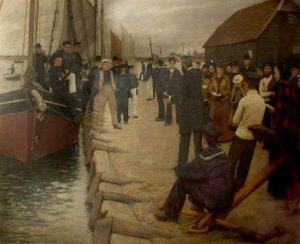The weekend of 15-17 July 2022 marks the 50th anniversary of the Bristol Harbour Festival. This event is a calendar highlight for many in the region, showcasing Bristol’s talent and heritage, and celebrating the diverse communities that form the heart and soul of the city. Set, as its name suggests, around the unique setting of Bristol’s harbourside, the festival hosts several events and activities with a maritime theme. This got us thinking about Bristol’s seafaring history, and what port cities in Britain might have been like a century or two ago.
Ahead of the festivities, we caught up with Professor Hilary Carey, Professor of Imperial and Religious History, and Dr Sumita Mukherjee, Associate Professor of Modern History, who have recently been awarded a grant, funded by the Arts and Humanities Research Council, on ‘Mariners: Religion, race and empire in British ports, 1801-1914′.
Can you tell us about your latest project?
We’re really excited to be working together on ‘Mariners’, which brings together our interests in the history of religion, race and empire. Spanning from 1801 to the beginning of the First World War, we are aiming to create a new religious history of missions to seamen. Marine missions were once ubiquitous features of British ports, coasts, canals and lighthouses where their objective was to save the drunken and lascivious sailor from themselves. They evolved into vitally important humanitarian societies which continue to support merchant crews around the world.
We are working in partnership with the Anglican Mission to Seafarers (founded in 1856) and the Hull History Centre to investigate the ways institutional missions grappled with local and global issues, including over-rapid expansion in the age of steam. We have a special interest in the mission work to lascars, the common term for Asian seafarers, who by the later decades of the nineteenth century made up to a third of the British marine workforce. We are also focusing on three port cities – Bristol, Hull and Liverpool – to show how local missions were integrated into port environments and the significance of their legacy today.
Why is this research important?
This research highlights the mentalities and realities of working seamen in the age of imperialism and the Christian charities which sought to convert and support them. Many of the problems faced by the merchant marine – from low wages, insecure employment and hazardous conditions to risk of shipwreck, piracy, disease and abandonment – remain just as urgent today. Some Victorians had a sentimental view of the work of missions to seamen, as in La Thangue’s 1891 painting of dockside evangelising. The reality – which is what we want to uncover – was rather different.

How will you go about the research?
One of the key research collections we’ll be using is the Mission to Seafarers archives, deposited in Hull History Centre between 2005 and 2014. There are 98 linear metres of archives, so there’s a lot to get stuck into! Alongside this, a key focus of the project is on Asian seamen, and we’ll be bringing together a huge range of official reports as well as material on dedicated homes for Indian seamen across a number of British ports. We’ve already found some wonderful photos which we’re excited to share in the future.
Lascars found it particularly challenging to find accommodation in British ports, and there were few places which catered to their needs. We want to find out more about places such as the Mere Hall Hostel for Indian seamen in Liverpool and the London Strangers’ Home for Asiatics, Africans and South Sea Islanders, which opened in 1857.

Can you tell us about some of the Bristol connections?
Bristol is and was a significant port, and has always supported charities for poor sailors, including those shipwrecked, disabled and too old to work. The Bristol Channel Mission, founded by John Ashley in 1835, was one of the first organised missions for seamen, later incorporated into today’s worldwide Mission to Seafarers. There was also a Floating Seamen’s Chapel, and even a Home for Seamen’s Orphan Boys, established in 1859 in Brixham, Devon, by William Gibbs, the wealthy owner of Tyntesfield, near Bristol.
As in other ports, many of Bristol’s sailors’ homes and missions have been destroyed, including the Seamen’s Mission Chapel at 53 Prince Street which was badly damaged in the Bristol Blitz on 2 December 1940. Other sites have been demolished outright, as sailors no longer require the services they used to access in missions, sailors’ homes, or even the wild, old sailor towns. We hope to keep the memory alive of why these places were built and what they tell us about Bristol’s maritime past.
What impact do you expect the research to have?
Part of the project will involve some oral history interviews with existing and retired marine chaplains. We’re also going to commission some artistic impressions of marine missions. We’re hoping to include these on our website and in a forthcoming exhibition, and alongside this engage in several public talks and with schoolteachers. We hope our project will deepen understanding of the multi-racial and multi-faith nature of Britain and British maritime history, and we’re excited to see what develops from this.
What are the next steps?
We’re looking forward to appointing two postdoctoral researchers, hopefully to start in January 2023, to work closely with us on this project, alongside a dedicated project administrator. We’ll be hosting a conference in 2024 and a visiting exhibition in 2025, but first a dedicated project website should be up next year. Watch this space for more news and links to our activities!
Find out more about research in the Faculty of Arts.

